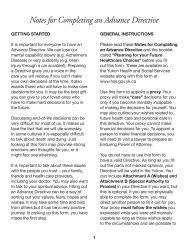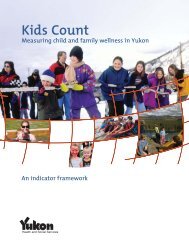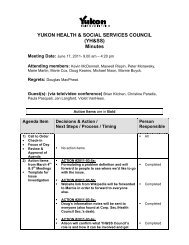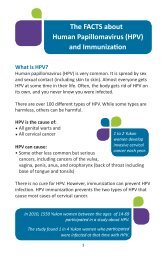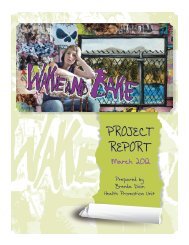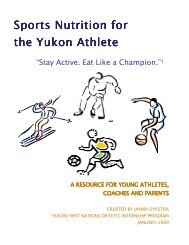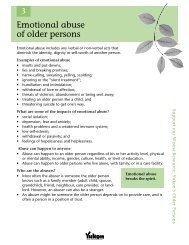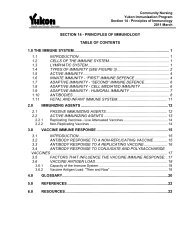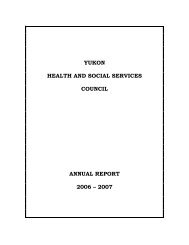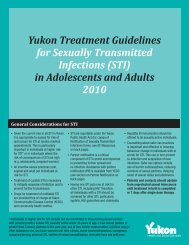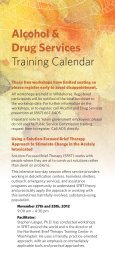Supporting Adults Affected by FASD with Complex Needs ©2010
Supporting Adults Affected by FASD with Complex Needs ©2010
Supporting Adults Affected by FASD with Complex Needs ©2010
Create successful ePaper yourself
Turn your PDF publications into a flip-book with our unique Google optimized e-Paper software.
Walking the Journey Together: <strong>Supporting</strong><br />
<strong>Adults</strong> <strong>Affected</strong> <strong>by</strong> <strong>FASD</strong> <strong>with</strong> <strong>Complex</strong><br />
<strong>Needs</strong> ©2010<br />
Brenda Bennett, Executive Director<br />
<strong>FASD</strong> Life’s s Journey Inc.<br />
17-794 794 Sargent Avenue<br />
Winnipeg, Manitoba R3E 0B7<br />
b.bennett@fasdlji.ca<br />
1-204-772-1591
My Manitoba….<br />
Population 1.3 million<br />
Capital city is Winnipeg, Manitoba<br />
Winnipeg has serious safety and security<br />
problems<br />
Identified as the crime capital of Canada<br />
Significant Aboriginal population in<br />
Winnipeg, expected to continue to grow<br />
rapidly due to urbanization
Our Winnipeg..<br />
The closer to the city’s s geographic centre, the higher the<br />
incidence of violence and property crime<br />
Such crimes are the product of poverty and social<br />
exclusion and are concentrated in the inner city<br />
Policing strategy for the inner city is incident driven<br />
policing – 911<br />
2005 introduced Operation Clean Sweep – zero<br />
tolerance policing based on New York City model –<br />
created great divide between police and community<br />
First Nations population that struggles <strong>with</strong><br />
transgenerational affects of colonization
<strong>FASD</strong> Life’s s Journey Inc.<br />
Evolved from a 2002 Coalition on Alcohol<br />
and Pregnancy (CAP) sponsored Think Tank<br />
on the service needs and gaps for adults and<br />
late adolescents affected <strong>by</strong> <strong>FASD</strong><br />
Broad range of stakeholders participated to:<br />
Identify the needs<br />
Identify the service gaps, and<br />
develop an action plan to address<br />
the issues
The Response….<br />
Development of the Manitoba FAS<br />
Community Mobilization Project – 3 year<br />
broad based community development<br />
initiative<br />
17 initiatives including the development of<br />
a direct service model for late adolescents<br />
and adults impacted <strong>by</strong> <strong>FASD</strong> & an <strong>FASD</strong><br />
focussed agency in Manitoba
<strong>FASD</strong> Life’s s Journey Program<br />
Began providing intake and supportive<br />
services in the fall of 2002<br />
Direct service demonstrated the support<br />
needs of this population<br />
Provided neurodevelopmental services<br />
that government programs valued and<br />
relied on
<strong>FASD</strong> Life’s s Journey Inc.<br />
By June 2005 secured funding for the<br />
continuance of the direct service program<br />
through the newly formed <strong>FASD</strong> Life’s<br />
Journey Inc.<br />
September 2005 <strong>FASD</strong> Life’s s Journey Inc.<br />
initiated services for late adolescents and<br />
adult Manitobans affected <strong>by</strong> <strong>FASD</strong>
<strong>FASD</strong> Life’s s Journey’s s Path<br />
over five years<br />
2005 2010
Definition of <strong>Complex</strong><br />
Whole made up of complicated or<br />
interrelated parts<br />
A group of obviously related units of which<br />
the degree and nature of the relationship<br />
is imperfectly known.<br />
Intricate, involved meaning having<br />
confusingly interrelated parts<br />
Hard to separate, analyze or solve<br />
Webster’s s 7 th new Collegiate Dictionary – purchased at Young’s s Stationary Ltd in Saskatoon
<strong>Complex</strong> Issues & <strong>FASD</strong><br />
When supporting <strong>FASD</strong> affected individuals we are<br />
confronted <strong>with</strong> the addition of a myriad of complex<br />
issues that are very difficult to support, manage &<br />
explain.<br />
We experience the reality that there is a growing gap<br />
between the complexity of these problems and the<br />
human capacity to comprehend them and to deal <strong>with</strong><br />
them.<br />
In this situation there is a need for better methods and<br />
tools, more knowledge and imagination then there<br />
seems to be available in our standard domains of<br />
knowledge, even in the realms of scientific knowledge.
Our consumers…<br />
Individuals who have developmental disabilities<br />
(IQ less than 70) and adaptive functioning<br />
deficits (existing prior to age 18)<br />
Co-occurring occurring disorders – schizophrenia, conduct<br />
disorder, PTSD, etc.<br />
Chronic neuropsychiatric abnormalities<br />
Frequently homeless<br />
Have failed in repeated “treatment” settings and<br />
across the lifespan<br />
Frequently in trouble <strong>with</strong> the law – often same<br />
crime over and over and repeatedly breaking<br />
probation or parole conditions
Our Consumers<br />
Their behaviours are interpreted as willful and non<br />
compliant<br />
Their children are relinquished to care<br />
Attitude that “being bad is better than being stupid”<br />
Chronically unemployed<br />
Involved in violent domestic relationships<br />
Have high degree of health problems including<br />
HIV/AIDS, HEP-C, diabetes, seizure disorders, STI’S<br />
Have committed violent and serious criminal offences<br />
Socially vulnerable<br />
Criminalized due to disability<br />
Have histories of severe neglect, physical and sexual<br />
abuse
Our Consumers…<br />
Pose risk to self or community<br />
Have spent significant portions of their life<br />
incarcerated/institutionalized<br />
Have almost non existent family<br />
involvement<br />
Highly street and gang involved<br />
Are at various stages of change related to<br />
their addiction(s)<br />
Survivors of CFS care
Brain Based Disability - <strong>FASD</strong>
9 Brain Domains
All Behaviour Isn’t t Due to <strong>FASD</strong><br />
<strong>Complex</strong> trauma<br />
Developmental Disability<br />
Acquired brain injury<br />
Environmental –their<br />
“Normal”<br />
Significant physical and sexual abuse<br />
Neuropsychological deficits related to substance<br />
abuse<br />
Mental health disorders<br />
Addiction related<br />
Chaotic developmental history<br />
Reactive attachment disorder
<strong>Complex</strong> Issues<br />
Unlikely to make sufficient change to own<br />
internal resources to result in meaningful,<br />
observable change<br />
Autonomic (involuntary)nervous system arousal<br />
when dealing <strong>with</strong> potent content issues<br />
Neuropsychiatric abnormalities (ADHD)<br />
Egosyntonic <strong>with</strong> respect to substance use<br />
Reactivity, impulsivity and attention problems<br />
Low stress tolerance<br />
High risk behaviours that pose risk to self or<br />
community
<strong>Complex</strong> Issues<br />
High societal expectations for change/cure<br />
<strong>Complex</strong> systems involvement <strong>with</strong> varying<br />
degrees of understanding of <strong>FASD</strong> and related<br />
complex issues<br />
Struggle of dependence vs. independence<br />
Grief issues related to living <strong>with</strong> a disability<br />
Rage issues related to the chronic and<br />
persistent harm that they have survived<br />
There is little to no generalization of skills<br />
acquired through traditional residential inpatient<br />
addictions programs
<strong>Complex</strong> Issues<br />
Stability will fluctuate and change over<br />
time<br />
History of multiple caregiver burn out<br />
Disruptions in development<br />
Typical developmental stages do occur,<br />
but at different times – some behaviours<br />
may be an expression of normal<br />
development (what age of development<br />
does the behaviour feel like?)
<strong>Complex</strong> Issues<br />
Co-morbid mental health disorders across<br />
multiaxial dimension e.g. dissociative identiy<br />
disorder (formerly multiple personality disorder),<br />
borderline Personality Disorder & antisocial<br />
personality disorder<br />
High risk, sensation seeking behaviour<br />
Sensory over stimulation<br />
Attachment Issues<br />
Toxic pervasive shame – All-pervasive sense<br />
that they are flawed & defective human beings
Social Conditions<br />
Colonization<br />
Exploitation & victimization<br />
Cultural Discrimination<br />
Neglect<br />
Life experiences<br />
Shame and blame<br />
Multiple placements through CFS<br />
Normalization of substance abuse<br />
Normalization of inappropriate sexual behaviour<br />
Partner substance abuse & domestic violence<br />
Poverty<br />
Sexual and physical abuse<br />
<strong>Complex</strong> trauma
Secondary Characteristics<br />
Self harm behaviours, suicide threats<br />
Emotional/physiological problems<br />
Eating disorders<br />
Sexual offending history<br />
Substance abuse & treatment history<br />
Homelessness/transient<br />
Co-morbidities<br />
ABI<br />
Health issues
Secondary Characteristics & Social Conditions
Best Practices<br />
Statements based on<br />
scientific evidence<br />
and/or on the<br />
perspectives of<br />
consumers, expert<br />
practitioners and<br />
educators
In the Absence of Research…<br />
It is important to note that the amount of research<br />
conducted to evaluate the effectiveness of any<br />
intervention intended to provide appropriate care<br />
and support for individuals affected <strong>by</strong> prenatal<br />
alcohol and other drug use, has been quite limited.<br />
This is particularly the case <strong>with</strong> interventions<br />
directed to adolescents and adults. In light of this,<br />
observations of experts that work <strong>with</strong> these<br />
populations are brought into the discussion to a<br />
greater extent.<br />
Health Canada 2001
Service Model<br />
Practice based model that utilizes a best practices<br />
approach based on the longitudinal finding of A.P<br />
Streissguth (1997), Health Canada, others prominent<br />
in the field, and anecdotal experience gained<br />
through <strong>FASD</strong> Life’s s Journey Inc. programs<br />
Case management (advocacy) mentorship model
Program Model<br />
Neurodevelopmental<br />
Framed <strong>by</strong> a harm reduction and<br />
empowerment philosophy<br />
Recognizing the lifespan nature of the<br />
disability – won’t t accept temporary<br />
funding for an individual
The Model<br />
Individualized and holistic<br />
Gender specific<br />
Expectations are based on understanding<br />
unique needs – strengths & disabilities<br />
across the lifespan<br />
Focus on the primary disabilities<br />
Habilitative in nature<br />
Culturally responsive<br />
Change environments not people
Service Model<br />
The model is not silo based<br />
It is designed to meet relevant individual<br />
needs.<br />
The model doesn’t t attempt to modify the<br />
individual to fit the system.<br />
It is a system that accommodates <strong>FASD</strong> and<br />
its diversity
Neurobehavioural Case Management/Mentorship Model<br />
• Multi system collaborative continuum of care<br />
• Practice based model based on therapeutic theories utilizing a best b<br />
practices<br />
approach based on the longitudinal research finding of A.P Streissguth<br />
(1997), Health Canada, Diane Malbin, others prominent in the field, and<br />
anecdotal experience gained through the <strong>FASD</strong> Life’s s Journey Program<br />
• Case management (advocacy) mentorship<br />
• Neurodevelopment approach to neurobehavioural challenges<br />
• Honours safe cultural and spiritual choices of consumers<br />
• Individual & gender centred – they are the experts on who they are and what<br />
they need to live <strong>with</strong> their disability<br />
• Recognizes the lifespan nature of the disability<br />
• Understands and accommodates for a trauma perspective that doesn’t<br />
blame the victim<br />
• Appreciates the significant interconnectedness between traumatic<br />
victimization and substance abuse<br />
• Modify environments to ensure they are conducive to positive<br />
interdependent living<br />
• Reconnect <strong>with</strong>, or facilitate development of, caring social relationships<br />
• Adult and Youth <strong>FASD</strong> Neurobehavioural - Case Management Mentorship Model (Bennett<br />
and Wyllie 2002) ©
Program Features<br />
Prevent <strong>FASD</strong> through primary prevention efforts <strong>with</strong><br />
consumers<br />
Improve lifelong outcomes through the provision of<br />
appropriate and accommodating service delivery<br />
Responsive to vulnerable youth and adults<br />
Designed to achieve maximum interdependence<br />
Community intake through one point of access<br />
Screen individuals to enter a coordinated &<br />
complimentary continuum of supportive services<br />
Key case workers will develop engaging, culturally<br />
appropriate, mentorship relationships<br />
Assess functionality through the use of functional<br />
assessment tools so that supports can be appropriately<br />
targeted to each individuals needs<br />
Identify service/support needs of the consumers<br />
Develop individualized transitional /or habilitative plans
Program Features<br />
Utilize transitional teams/network of support that are inclusive of<br />
service partners and those adults identified <strong>by</strong> the individual as a<br />
significant in their life<br />
A primary focus on elucidating the individuals long term<br />
neuropsychological consequences of <strong>FASD</strong><br />
Coordination of services among a multidisciplinary network defined<br />
ed<br />
<strong>by</strong> the consumers needs<br />
Screen and refer youth for diagnostic services<br />
Provide culturally appropriate services that strengthen the ties to<br />
their culture and communities<br />
Strengths based<br />
Gender specific and responsive<br />
Document the progress and evaluate program outcomes<br />
Identify emerging issues ongoing and advocate for the development<br />
of services identified as gaps in the service system<br />
Provide basic life essentials<br />
Referral to programs where eligible to meet relevant needs<br />
Reintegration to community from Provincial Correctional facilities
The Culture of the Services<br />
• Promoting protection and safety<br />
• Individual centered - Consumers must<br />
have a discernable influence over<br />
their life –even if small steps initially<br />
• Fostering of interdependence, not<br />
independence<br />
• Respectful - accepting & non<br />
judgmental based on<br />
• Relational – building and<br />
maintaining positive, trust based<br />
supportive relationships that are<br />
caring and consistent<br />
• Trauma Informed - account for the<br />
trauma perspective<br />
• Gender Centered - women-centered,<br />
men-centered<br />
• Provides necessary life resources<br />
• Harm Reduction Oriented – minimize<br />
known harms associated <strong>with</strong><br />
substance use<br />
• Individualized -Accommodate the<br />
individuals unique needs and<br />
deficiencies <strong>with</strong> realistic social<br />
expectations based on the persons<br />
actual abilities<br />
• Culturally competent & culturally<br />
safe<br />
• Strengths based<br />
• Voluntary – non mandated<br />
• Use of a Neurobehavioural Lens -<br />
Belief that behaviours are acting<br />
out of disability<br />
• Proactive approach to anticipate<br />
and avoid problems and also a<br />
reactive response to provide<br />
assistance when crisis occur.<br />
• Reconnect <strong>with</strong>, or facilitate<br />
development of, caring social<br />
relationships<br />
• Holistically health promoting
Services are informed <strong>by</strong> the<br />
following:<br />
Functional assessments – SIB-R, ICAP,<br />
etc.<br />
Diagnostic assessment (where available)<br />
Identification of the brain domains<br />
Clinical consultation<br />
Social mapping<br />
Consumer identified/endorsed support<br />
Consumers cultural and spiritual context
Neuropsychological<br />
Assessments<br />
Neuropsychological assessment from a<br />
practitioner knowledgeable regarding <strong>FASD</strong><br />
Neuropsychological assessment will identify<br />
cognitive and functional deficits and individual<br />
strengths<br />
Once the strengths and weakness profile is<br />
established it will assist to construct strategies<br />
and accommodations
<strong>FASD</strong> Neurobehavioural Domain<br />
Domains<br />
Communication<br />
Adaptive behaviour<br />
Assessment tools<br />
California verbal learning<br />
test 2nd edition, sensory<br />
motor difficulties, sensory<br />
motor profile<br />
Observation, adaptive<br />
behaviour<br />
Cognition<br />
Executive Functioning<br />
Attention deficit/hyper<br />
activity<br />
Academic/higher order<br />
problem solving<br />
Wechsler adult intelligence<br />
scale-3 rd edition<br />
Behaviour rating inventory<br />
of executive functioning<br />
(BRIEF)<br />
Observation, Connors rating<br />
scale<br />
Halstead category test
The Service Team
“People Make the Difference,<br />
Not Programs”
Multi-Disciplinary Service Team<br />
Clinical Case Manager<br />
Psychiatric consultations/assessments-risk<br />
assessments, functionality assessments,<br />
brain domains, offender counselling, etc.<br />
Occupational therapy consultations,<br />
assessments and recommendations<br />
Case Workers/Support Mentors<br />
Elders / Cultural Workers<br />
Those family or friends important to the adult<br />
Community Collaterals – Probation, CFS,<br />
EIA, MH, other community agencies, etc.
Case Study
Axis I<br />
Cocaine dependency<br />
Cannabis dependency<br />
PTSD chronic and severe<br />
Learning disorder<br />
ADHD<br />
Rule out dissociative disorder
Axis II Diagnosis<br />
Mental retardation<br />
Effects of exposure to ethanol in utero<br />
Personality disorder (NOS) – borderline,<br />
antisocial, compulsive sexual acting out
Axis III<br />
Pregnancy<br />
Recurrent STI’s
Axis IV<br />
Ongoing chaotic and dangerous lifestyle, severe<br />
childhood neglect, chaos and abuse, active in<br />
sex trade, past poor adherence to medication,<br />
burned out many resources<br />
Ongoing relationship that is not in agreement<br />
<strong>with</strong> the treatment team<br />
Strengths & resources - sense of humour,<br />
enjoys music, and dancing, decreasing cocaine<br />
use, beginning to respond to structure and<br />
support
Protective Factors<br />
Develop relationships over the course of time in<br />
a non demanding and non threatening<br />
atmosphere<br />
Utilize situational inducement which adapts the<br />
environment in order to mitigate concerning<br />
behaviour<br />
A long term approach to begin to engage in a<br />
longer term relationship even though the<br />
individual will remain very high risk in the context<br />
of their current lifestyle and substance use
Protective Factors<br />
Psychotropic medication<br />
Structure, support, routine<br />
Appropriate level of support in a<br />
safe/secure residential setting<br />
Integrate the therapeutic approach <strong>with</strong>in<br />
the context of the individuals day to day<br />
lifestyle<br />
Require longer term re-socialization<br />
Adapted environment
Assessing Appropriate Housing<br />
Related to Risks<br />
Inconsistent psychiatric function –<br />
psychosis<br />
Neuropsychological deficits related to<br />
substance abuse<br />
IQ level (55-68)<br />
Adaptive functioning that precludes them<br />
from living on their own
Residential – Men’s<br />
“Running and gunning”<br />
Extreme behaviour – arson, sexual<br />
assaults, manslaughter, harassment, utter<br />
threats, breach of probation, car theft, B &<br />
E, trafficking, possession, assault <strong>with</strong> a<br />
weapon, mischief, destruction of property
Women’s s Residential<br />
Due to extreme vulnerability to exploitation<br />
Pose significant risk to community or self<br />
Parenting home to allow mothers a role in<br />
mothering to the extent possible<br />
Severe addiction issue that place them at risk of<br />
harm in the community<br />
Those <strong>with</strong> significant mental health disorders<br />
who require significant support to comply <strong>with</strong><br />
medication management or physical health<br />
issue such as diabetes or HIV/Aids.
Foster Placements<br />
Social vulnerability -Vulnerable to<br />
exploitation and victimization<br />
Don’t t have extreme psychiatric issues<br />
Small stature males <strong>with</strong> FAS diagnosis –<br />
they feel safe in foster placements than<br />
living interdependently in the core area of<br />
Winnipeg where they are victimized and<br />
exploited
<strong>FASD</strong> & Addictions
Inpatient Addiction Treatment<br />
To benefit from inpatient addictions<br />
programs the individual must be:<br />
• Ego-dystonic (cognitively able to internalize<br />
concepts)<br />
• Have the ability to generalize these concepts<br />
outside of the parameters of the stimulus<br />
context <strong>with</strong>in which they are taught
Addictions Screening & Response<br />
• Utilize in house addictions screening questions specific to this population that accommodates for<br />
their communication and cognitive challenges.<br />
<br />
<br />
<br />
<br />
<br />
<br />
Screening questions will occur in a manner that is comfortable and a<br />
safe for the consumer<br />
(SAMHSA 2003).<br />
We undertake the initiation of conversations regarding substance use which provides an<br />
opportunity to assist the individual to connect substance abuse <strong>with</strong> unfavorable consequences<br />
e.g. incarceration. It is common that affected individuals have not identified that they have<br />
addiction issues and that they will know when to access addictions treatment.<br />
Addiction screening will occur through an incorporation of questions into practical conversations<br />
that program staff have <strong>with</strong> consumers. In these conversations we will identify factors that have<br />
enhanced and or hindered their ability to achieve abstinence or reduce harms related to<br />
substance use.<br />
We utilize the stages of change model (Prochaska and Di Clemente -1986) to develop<br />
individualized addiction supports in tandem <strong>with</strong> making environmental ental adaptations to support<br />
success. This model is preferred as it is based on collaboration n <strong>with</strong> those who are receptive to,<br />
or not yet open to or able to, pursuing change.<br />
Staff have a non judgmental attitude and the intent of encouraging and empowering consumers to<br />
pursue positive life changes <strong>by</strong> adapting their environment. Program staff do not have a moral<br />
evaluation of consumers’ behaviours or substance preferences.<br />
Referrals are made to existing Manitoba addictions programming available a<br />
at Addictions<br />
Foundation of Manitoba, Behavioural Health Foundation, Marymound (Meth unit), etc. Program<br />
staff will assist the treatment program to accommodate for the affects a<br />
of <strong>FASD</strong>.
“Probations Substance Prohibition<br />
Consequences<br />
Not a matter of prohibiting substance use –<br />
individuals need to develop the personal<br />
supports and internal resources for any reliable<br />
change to occur in their substance use habits<br />
Entanglement in the subsequent legal<br />
consequences only further remove then from<br />
community based programming and place them<br />
in harms way <strong>with</strong> their “range mates”
Harm Reduction Features..<br />
Pragmatism: Harm reduction accepts that<br />
some use of psychoactive substances is<br />
inevitable, and that substance use can be<br />
expected (80%) as a secondary disability<br />
in the absence of universal protective<br />
factors.
Harm Reduction..<br />
Humane Values: The dignity and rights of<br />
the person who uses substances are<br />
consistently respected. No moralistic<br />
judgment is made, either to condemn or to<br />
support use of substances regardless of<br />
the level of use or the method of intake.
Harm Reduction<br />
Focus on Harms & the Primary Disability:<br />
The extent of the person’s s substance use<br />
is of secondary importance to the harms<br />
resulting from that use. We do not treat<br />
individuals for their secondary disability<br />
rather than their primary disability.
Harm Reduction<br />
Hierarchy of goals: : The individuals most<br />
pressing needs are addressed first. The<br />
harm associated <strong>with</strong> substance use and<br />
abuse can include: dependence, chronic &<br />
acute health problems, accidents,<br />
aggression & violence, alcohol & drug<br />
related crime, overdose, public nuisance &<br />
contribution of infectious diseases such as<br />
HIV/AIDS, Hepatitis C, significant<br />
victimization and chronic homelessness.<br />
Adapted from Marlett, G.A & Gordon, J.R. (1989)
<strong>FASD</strong> & Addictions <strong>Needs</strong> © Bennett.B 2006<br />
Access to immediate detox services<br />
Addictions treatment should ideally take place<br />
in their natural environment<br />
Long term residential /supported<br />
environment/program<br />
Alternate to traditional addiction models based<br />
on adapted cognitive behavioural approaches<br />
Stages of change and motivational<br />
interviewing (adapted to accommodate for<br />
primary disability)<br />
Daily reinforcement <strong>with</strong> a focus on pro-social<br />
activities, lifestyle and <strong>with</strong> competing<br />
responses to substance use/abuse<br />
Emphasize enhancing self esteem, self<br />
respect and promote interdependency<br />
Environmental adaptations
<strong>FASD</strong> & Addictions <strong>Needs</strong><br />
© Bennett. B 2006<br />
Create a peer network that is healthy and<br />
functional –this can be very challenging<br />
More structure and less free time <strong>with</strong> an<br />
emphasis on life skills, leisure and recreational<br />
activities<br />
Eliminate or reduce triggers – e.g. location of<br />
residence, money, people, etc.<br />
After care program adapted to individual needs<br />
in their natural environment<br />
Utilize individualized harm reduction strategies<br />
Account for the trauma perspective & respect<br />
the interconnectedness of trauma and<br />
substance abuse
Addiction Treatment Should:<br />
Be adapted<br />
Take place <strong>with</strong>in the individuals natural environment<br />
Promote and validate their attendance <strong>with</strong>in the residential<br />
placement<br />
Be reinforced daily<br />
Focus on pro-social activities, lifestyle and competing responses to<br />
substance use/abuse.<br />
Place emphasis on self esteem, promoting autonomy, self respect,<br />
and create peer network that is healthy and functional<br />
Emphasize life skills, recreation,leisure<br />
Decrease anxiety <strong>with</strong> intervention around transitional issues, social s<br />
stories, and teachable moments<br />
Due to Axis II pathologies this intervention must be ongoing across<br />
time<br />
Respect the individuals spiritual journey
Challenges..<br />
Need a Neurobehavioural sensitive service system – ethical principles drive<br />
the work/involvement of collaterals and systems, however, this can c<br />
significantly interfere <strong>with</strong> the <strong>FASD</strong> specialists ability to provide supports to<br />
youth and adults<br />
Systems that focus on targeting behavioural symptoms rather then<br />
recognizing the causation of the behaviour – brain based<br />
High societal expectations<br />
Rehabilitation expectations vs habilitative focus across the lifespan<br />
Response of police in the absence of knowledge about the disability. ity. <strong>FASD</strong><br />
is an explanation not an excuse<br />
Belief that structure is a form of control
Challenges…<br />
Beliefs that structure, environmental<br />
adaptations and mentorship is simply<br />
“glorified ba<strong>by</strong>sitting”<br />
Tension between community living sector<br />
principles and beliefs, and the<br />
environmental adaptations implemented<br />
for those living <strong>with</strong> <strong>FASD</strong><br />
Mental health sector has a one size fits all<br />
approach to service
Challenges<br />
New agencies marketing themselves as<br />
<strong>FASD</strong> specialized when they don’t t utilize a<br />
best practice program model<br />
The internet<br />
Gang cultures and practices<br />
Economic downturn
How to Support Success…<br />
Adjust your expectations to the developmental age,<br />
which may be very different from the chronological age<br />
Receptive and expressive communication may not be<br />
the same. Often can repeat something back but may<br />
not fully understand it. Follow through <strong>with</strong> individual<br />
to ensure that understanding is reached.<br />
Validate their experience and emotions<br />
Develop a neurobehavioural sensitive service system<br />
– ethical principles drive the work/involvement of<br />
collaterals and systems, however this can significantly<br />
interfere <strong>with</strong> the <strong>FASD</strong> specialists ability to provide<br />
supports to youth and adults<br />
Have patience <strong>with</strong> systems – your focus is to<br />
advocate and educate
How to Support Success…<br />
Repetition of directions/instructions – allows<br />
information to be stored in the habit area of the<br />
brain (hippocampus) where it will be<br />
remembered more easily<br />
Routine and consistency help the individual<br />
make better sense of their world. This helps<br />
them function more effectively<br />
Impulsivity can make them impulsive at times<br />
and can affect their relationships. Role<br />
modeling and visual cues can help enhance<br />
interactions <strong>with</strong> others
Questions????


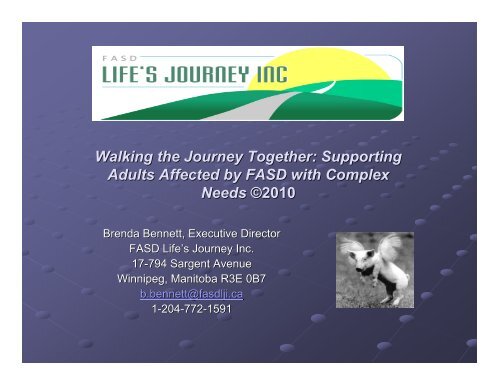
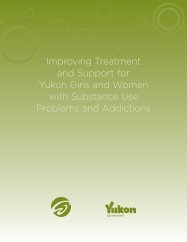
![Women and Alcohol: A women's health resource [2326.26 KB ]](https://img.yumpu.com/22340649/1/190x245/women-and-alcohol-a-womens-health-resource-232626-kb-.jpg?quality=85)
